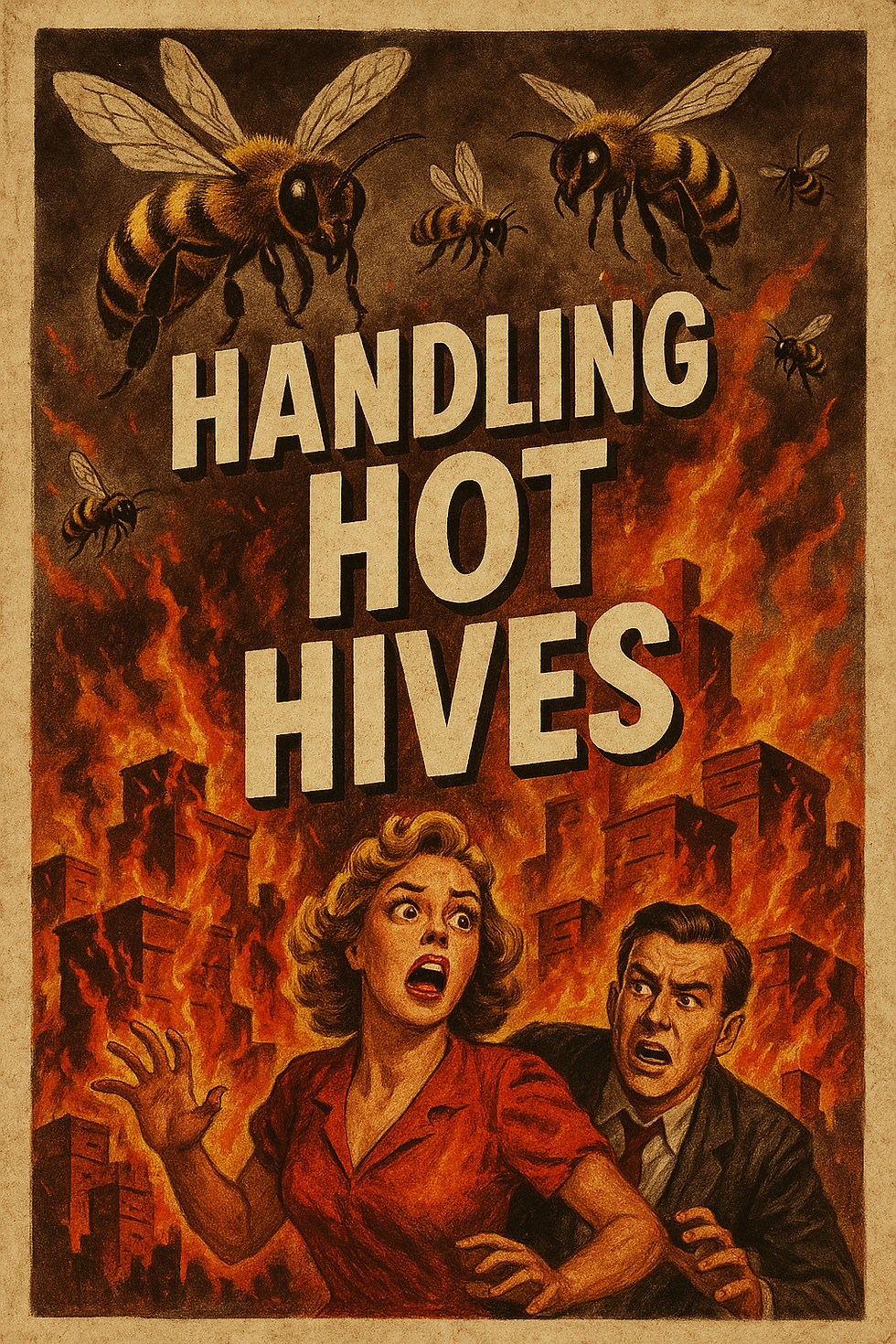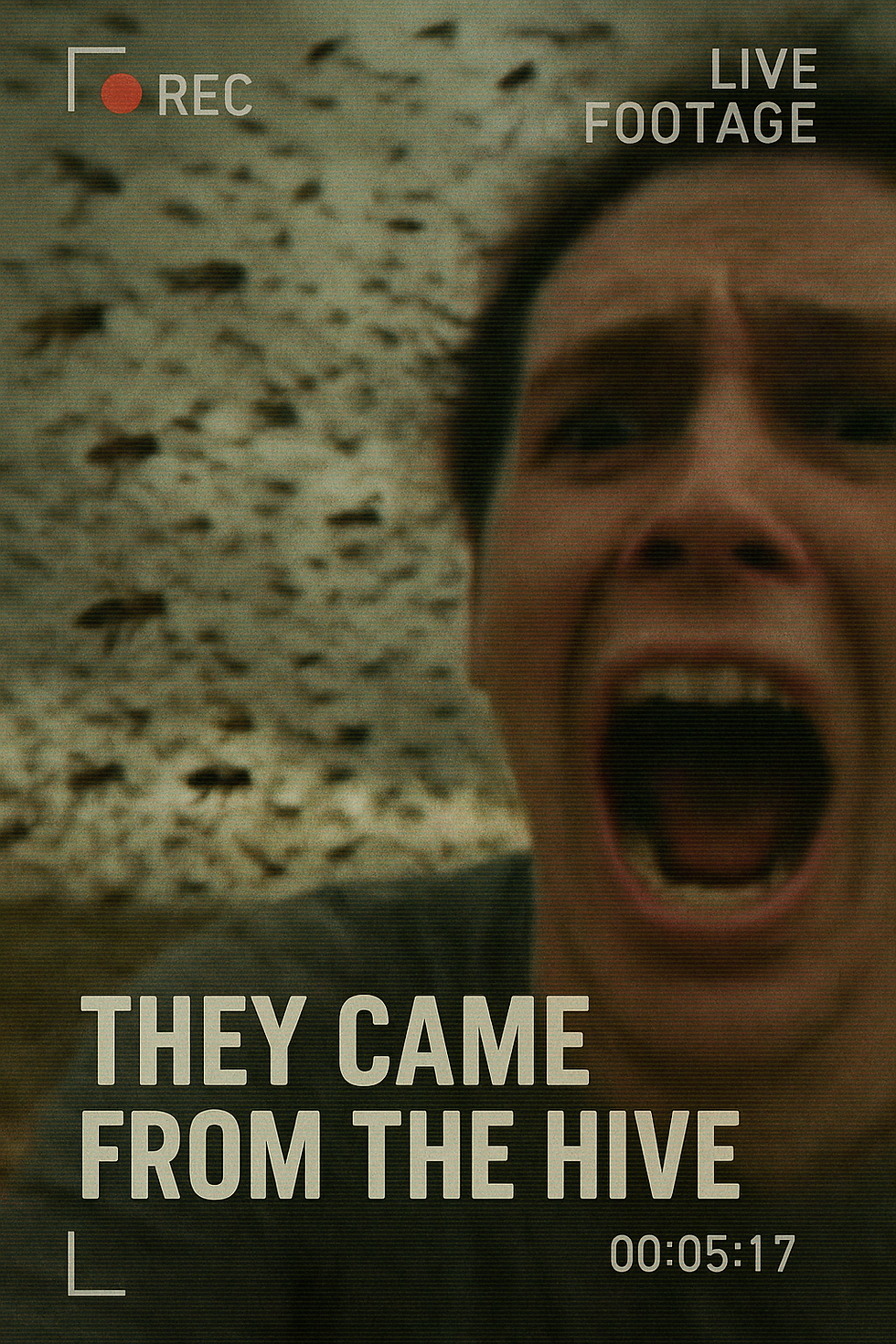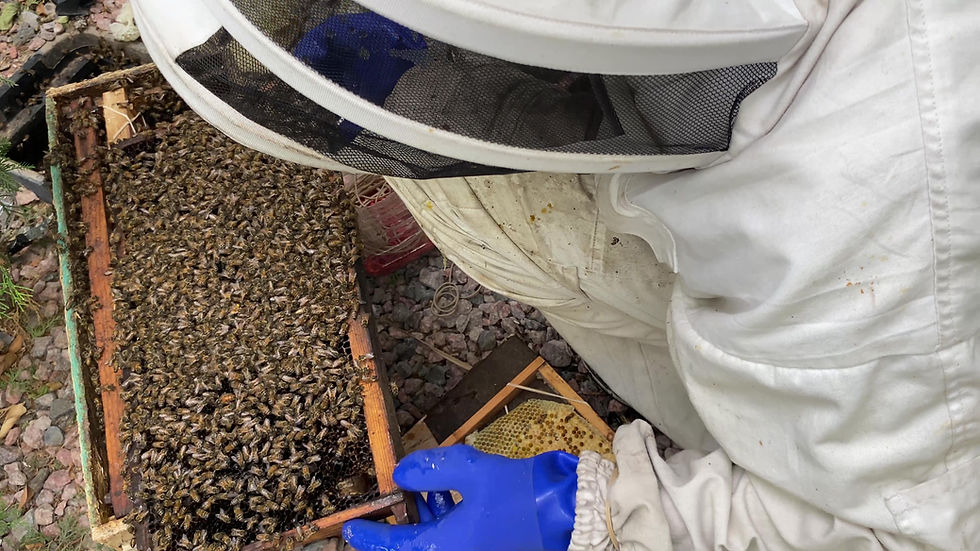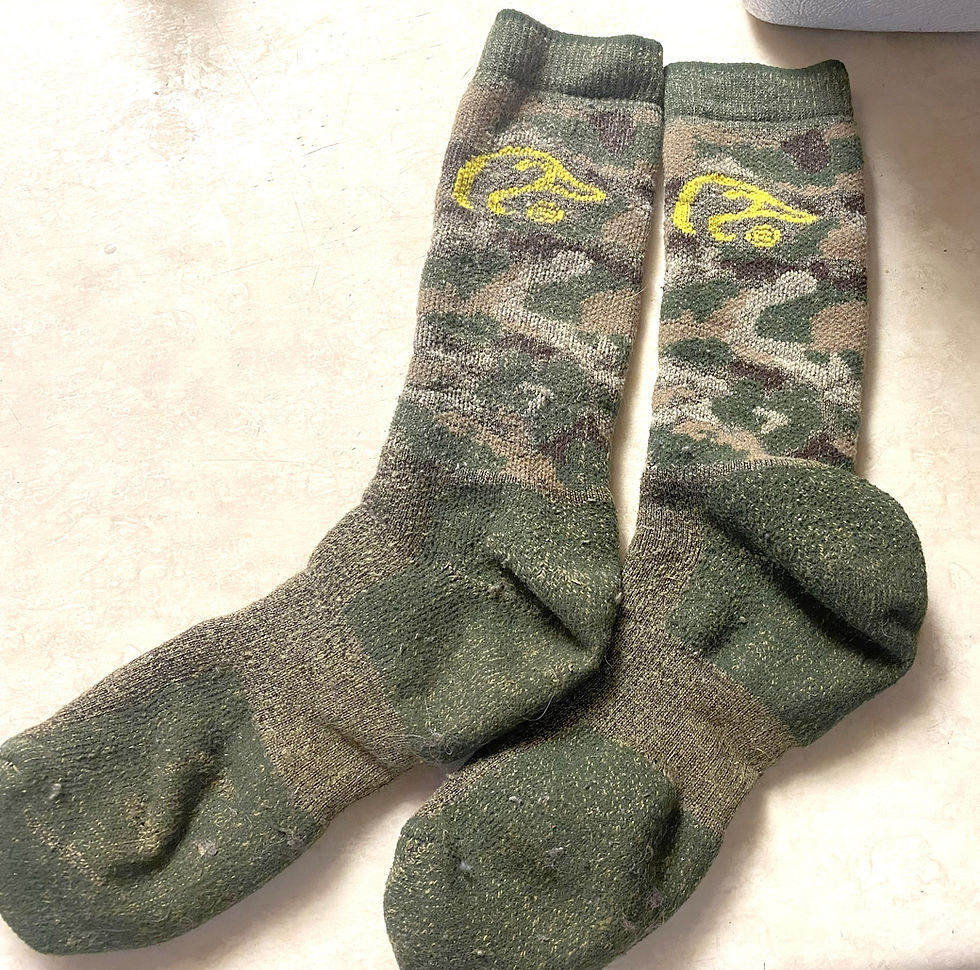How to Handle Hot Beehives and How to Cool Them Down.
- Pete Rizzo

- Aug 10
- 7 min read
Updated: Oct 20

What to do when your bees turn mean, become a hot beehive, and how to calm them down without losing the colony.
The Key Takeaways:
Most hot hives are caused by bad genetics, queenlessness, or stress
Always rule out temporary triggers before requeening
Introduce a new queen slowly and only after the hive is stable
Choose queen stock known for gentle traits (Italian or Carniolan)
Use full protective gear and smoke when working hot colonies
Don’t expect instant results as it takes 3 to 6 weeks to see improvement
Know when to walk away if a hive is too dangerous
Hot hives rarely mellow out on their own
Every beekeeper runs into it sooner or later. One day the hive that was calm and manageable suddenly feels like it's out for blood.
Smoke doesn’t help. They chase you away from the yard. They hit your veil, ping your suit, and sting just because you're nearby. That's a hot hive. And it's not something to ignore.
Left unchecked, they can sting your pets, harass your neighbors, and make your bee yard a nightmare. But the good news is, it doesn’t have to stay that way.
I’ve handled dozens of hot hives over the years, both in our removals and in our own apiaries. I’ve seen colonies that were too dangerous to walk near, and I’ve watched those same hives turn completely around after a few smart changes.
You have to know what you’re dealing with and have a plan. Oh, did I mention lots of
patience?

What Makes a Hive Go Hot
Bees aren’t naturally aggressive without a reason. A hot hive is reacting to something. Before you go tearing the hive apart or replacing the queen, take a step back and figure out the cause.
Bad queen genetics. This is the most common reason. A queen that mated with feral or Africanized drones will pass those traits to her daughters.
Queenlessness. If a colony is queenless, they often become unstable, unpredictable, and defensive.
Low on food. Hungry bees are desperate bees. If nectar is scarce or their stores are low, they'll become territorial.
Ants or robbing. Robber bees and ant pressure will drive a colony into panic mode.
Hive location. A hive that gets constant foot traffic, vibration, or animal activity may get defensive simply from stress.
Bad weather or recent trauma. Barometric changes, a storm, or even a skunk messing with the hive can throw them into a defensive state.
What I Do When a Hive Turns Hot
1. Ask yourself if it's just a bad day
Sometimes bees are just irritated by something temporary. Were you weed-whacking near the hive? Did a raccoon get into them last night?
Is it windy, humid, or stormy? Give it a few days. Then go back in when conditions are calm and see if they’ve mellowed.
2. Check for a queen
Look for eggs. If you don’t see any, and you don’t spot the queen, chances are they’re queenless. Queenless colonies act unstable and aggressive, so you’ll want to requeen them right away.

3. Check their food stores
Are the frames dry? No nectar, no honey? If so, they might be defending what little they have left. Sometimes I’ll take a frame of honey from a calm hive and drop it into the aggressive one.
It can have an immediate calming effect. Feeding can help too, but a frame of capped honey is like giving them a sense of security.
4. Deal with ants or robbing
Check for signs of robbing. Are bees fighting at the entrance? Are there wax crumbs or dead bees on the landing board? If so, reduce the entrance and use a robbing screen.
If you see ants, get rid of them fast. Ants put the bees into constant stress. I use Maxforce ant bait that the ants carry back to the colony.
It’s highly effective and takes care of the problem at the source.
5. Requeen with the right genetics
If the hive is queenright, has food, and isn't being robbed, the problem is likely the queen's genetics. That means it's time to requeen, but not with just any queen. You need to pick the right one.
What Kind of Queen to Use in a Hot Hive
Not all queens are created equal. If your goal is to calm the hive down, you have to choose your genetics carefully. Here’s what I’ve seen work and what I avoid.

Italian Queens
These are the gentle queens. Easy to manage, productive, and known for their docile nature. They draw comb fast and raise good brood. The downside is they can be more prone to robbing and might require more feeding in a dearth.
Best choice for calming a hive in a neighborhood or backyard.
Carniolan Queens
Also very gentle. They’re smart about resources and will adjust brood production based on nectar availability. Their only real downside is they can swarm if you don’t stay on top of them.
Good option if you want calm bees that adapt well to changing conditions.
Buckfast Queens
A balanced option. They’re calm, productive, and have good resistance to disease. They’re a hybrid, so sometimes their behavior can vary depending on the line, but I’ve had good results with them.
Great choice if you want mellow bees that can handle stress without going defensive.
Africanized or Feral Hybrids
These are the queens you want to replace. They can be defensive, they like to swarm often, and they usually don’t tolerate disturbance. If your hot hive raised their own queen after a supersedure, chances are she mated with feral drones and is making things worse.
Always replace these with a known, mated queen from a trusted source.

How to Introduce a New Queen
When requeening a hot hive, timing and technique are everything. If you just drop the new queen in, the bees will almost always kill her. Here’s what I do to give her the best chance:
Step 1: Make them queenless for 24 to 72 hours. Before introducing the new queen, I remove the old one (if she's present) and let the colony stay queenless for a day or three.
That short window helps reset their mindset. Without a queen's pheromones in the hive, the bees become more receptive to a new one. Just don’t go too long or they’ll start raising emergency cells and get even more defensive.
Step 2: Use a push-in cage on open brood: After that queenless period, I place the new queen in a push-in cage directly over open brood. That allows nurse bees to care for her while preventing them from attacking.
It also forces her pheromones into the brood area, helping them accept her faster. Leave the cage for three to four days, and then check for signs of acceptance.
Step 3: Candy release (only if behavior allows) If the bees aren’t balling the cage or showing aggression, you can remove the push-in cage and allow her to finish releasing through a candy plug. If they’re still testy, I’ll wait a little longer or manually release her during an inspection when I can monitor their response.

How Long Before the Hive Calms Down
Once the new queen is accepted, it takes about three to six weeks to see a full behavioral shift. That’s how long it takes for the old aggressive workers to die off and be replaced by her daughters. Don’t judge success too early. If she’s laying and they’re leaving her alone, you're on the right track.
What to Wear When Inspecting a Hot Hive
Hot hives are not the time to go in light. Here’s what I wear:
Full bee suit, zipped tight
Thick rubber gloves
Duct tape around the ankles and wrists so they won't crawl in
A pair of jeans and long sleeve sweatshirt under bee suit
A well-lit smoker, always in reach
This is going in smart because I never underestimate a hot hive.
When to Walk Away
If the hive is extremely defensive, and you’ve tried food, ant control, and requeening without success, it may be time to euthanize the hive. I know that sounds awful, but public safety has to come first.

Can a Hot Beehive Just Calm Down On Its Own?
Not likely. If the behavior is genetic, it will continue or get worse. Hot hives don’t usually mellow with time. If anything, they get more confident in their aggression. Waiting it out only delays the fix and increases the risk.
What If Neighbors Start Complaining
If your hive is near people, and they’re getting stung or scared, you need to act fast. Requeen the hive, move it if necessary, and let them know you're handling it.
Document what you’ve done to reduce aggression. That protects your bees and your liability. In cities like our beloved Las Vegas, complaints can lead to forced removals. Stay ahead of it.
Is Splitting a Hot Beehive a Good Idea
Sometimes. If the hive is large and full of bees, splitting it into two colonies can reduce the pressure and make requeening easier.
It also gives you a backup in case one half doesn’t accept the new queen. Just make sure both splits are strong enough to survive and that you requeen both sides with known genetics.
Bottom Line
Hot hives are frustrating, and sometimes scary. But they’re fixable. Most of the time the problem is genetics or stress, and both can be managed.
Don’t let aggression go unchecked. Take action, and the bees will follow your lead.
Feed them. Calm them. Requeen them with purpose. And don’t let fear make the decisions for you.
Betsy & Pete
🐝Las Vegas’s All-Natural Live Bee Removal Team
About Us: The Authors

We’re Betsy and Pete - Beekeepers on a Mission in Las Vegas
We’re not just in the bee business, we’re in the bee-saving business. Trained by a master beekeeper and backed by hundreds of successful removals, we are dedicated to rescuing and relocating honey bees with care and precision.
Every swarm we save and every hive we manage reflects our deep love for the bees.
At our Joshua Tree Preserve in Arizona, we care for dozens of thriving hives. Some wild, some honey-bearing, and all are part of our commitment to ethical, sustainable beekeeping.
Why Vegas Bees? Because We Never Stop Learning or Caring
Beekeeping is always evolving, and so are we. We stay on the cutting edge by continuing our education, connecting with fellow beekeepers, and refining our beekeeping practices and techniques to ensure the best outcomes for both bees and people.
Whether it’s advanced bee removal strategies or the latest natural methods, we’re always one step ahead.
We’re also proud to support the beekeeping community with high-quality beekeeping supplies for everyone. If you’re ready to suit up and start your journey, we’ve got what you need.
.png)


